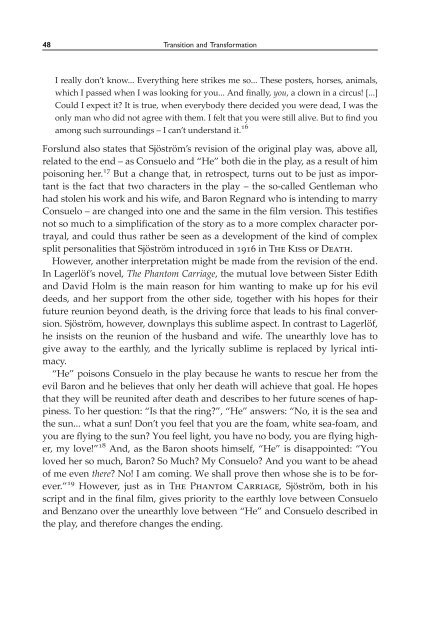FILM FILM - University of Macau Library
FILM FILM - University of Macau Library
FILM FILM - University of Macau Library
You also want an ePaper? Increase the reach of your titles
YUMPU automatically turns print PDFs into web optimized ePapers that Google loves.
48 Transition and Transformation<br />
I really don’t know... Everything here strikes me so... These posters, horses, animals,<br />
which I passed when I was looking for you... And finally, you, a clown in a circus! [...]<br />
Could I expect it? It is true, when everybody there decided you were dead, I was the<br />
only man who did not agree with them. I felt that you were still alive. But to find you<br />
among such surroundings – I can’t understand it. 16<br />
Forslund also states that Sjöström’s revision <strong>of</strong> the original play was, above all,<br />
related to the end – as Consuelo and “He” both die in the play, as a result <strong>of</strong> him<br />
poisoning her. 17 But a change that, in retrospect, turns out to be just as important<br />
is the fact that two characters in the play – the so-called Gentleman who<br />
had stolen his work and his wife, and Baron Regnard who is intending to marry<br />
Consuelo – are changed into one and the same in the film version. This testifies<br />
not so much to a simplification <strong>of</strong> the story as to a more complex character portrayal,<br />
and could thus rather be seen as a development <strong>of</strong> the kind <strong>of</strong> complex<br />
split personalities that Sjöström introduced in 1916 in The Kiss <strong>of</strong> Death.<br />
However, another interpretation might be made from the revision <strong>of</strong> the end.<br />
In Lagerlöf’s novel,The Phantom Carriage, the mutual love between Sister Edith<br />
and David Holm is the main reason for him wanting to make up for his evil<br />
deeds, and her support from the other side, together with his hopes for their<br />
future reunion beyond death, is the driving force that leads to his final conversion.<br />
Sjöström, however, downplays this sublime aspect. In contrast to Lagerlöf,<br />
he insists on the reunion <strong>of</strong> the husband and wife. The unearthly love has to<br />
give away to the earthly, and the lyrically sublime is replaced by lyrical intimacy.<br />
“He” poisons Consuelo in the play because he wants to rescue her from the<br />
evil Baron and he believes that only her death will achieve that goal. He hopes<br />
that they will be reunited after death and describes to her future scenes <strong>of</strong> happiness.<br />
To her question: “Is that the ring?”, “He” answers: “No, it is the sea and<br />
the sun... what a sun! Don’t you feel that you are the foam, white sea-foam, and<br />
you are flying to the sun? You feel light, you have no body, you are flying higher,<br />
my love!” 18 And, as the Baron shoots himself, “He” is disappointed: “You<br />
loved her so much, Baron? So Much? My Consuelo? And you want to be ahead<br />
<strong>of</strong> me even there? No! I am coming. We shall prove then whose she is to be forever.”<br />
19 However, just as in The Phantom Carriage, Sjöström, both in his<br />
script and in the final film, gives priority to the earthly love between Consuelo<br />
and Benzano over the unearthly love between “He” and Consuelo described in<br />
the play, and therefore changes the ending.

















